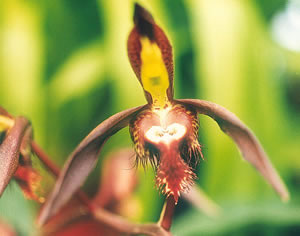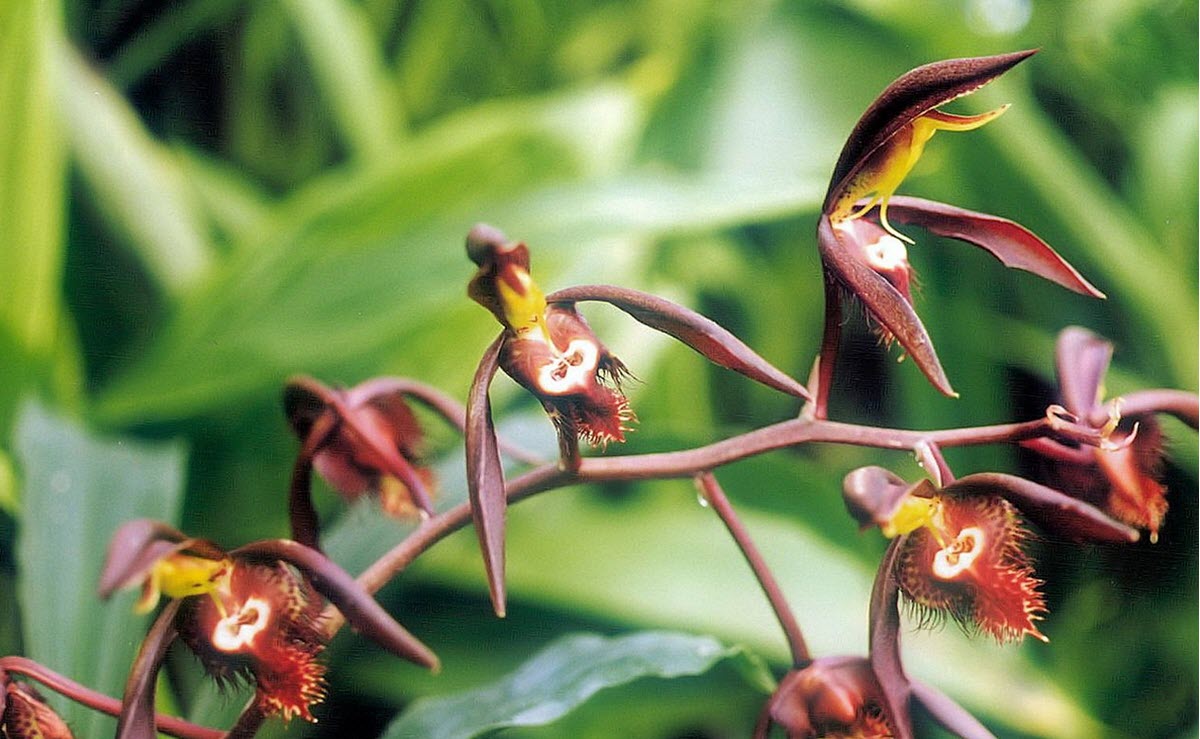Catasetum Orchid Care
Contents
The genus Catasetum belongs to the tribe Cymbidieae in the orchid family and Catasetum orchids can be found from Mexico to tropical America. A majority of the species are native to Brazil. The leaves of Catasetum orchids are pleated in the upper part. Catasetum orchids are almost always deciduous plants and that enters a dormant period when the shed their leaves.

Catasetum saccatum orchid
picture by: http://www.larsen.twins.dk
Understanding the rhythm of growing and resting periods is an essential part of successful Catasetum orchid care. These orchids have clustered pseudobulbs shaped like cigars. When the leaves have been shed, the pseudobulbs will become spiny.
The inflorescence of a Catasetum orchid is born on the basis and is made up by exceedingly fleshy flowers. Unlike most other orchids in the world, Catasetum orchids produce unisexual flowers, and they are normally situated on different plants. The male flower is very colourful while the female flower is less conspicuous yellowish to green shade. The conditions in which you grow your Catasetum orchid will determine whether the flowers of the plant become male or female. A Catasetum orchid growing in intermediate conditions can produce both male and female flowers, but this is very rare and the flowers will be different in size as well as colour. It is easy to mistake such a plant for a completely different species and even orchid experts did so initially.
Watering
Watering Catasetum orchids is naturally an essential part of their care and will greatly determine if really big pseudobulbs will develop or not. During the comparatively short growing season, the Catasetum orchid must be given opportunity to store a lot of water. As long as new leaves are being formed, you must water your Catasetum orchid a lot. Gradually reduce the watering frequency as the pseudobulbs mature. When the leaves start to become yellow and drop, it is time to stop all watering until you can notice new growth. If the pseudobulbs begin to shrivel really severely, it can however be okay to give the orchid some water during the dormant period.
Nutrients
In order to develop strong pseudobulbs the Catasetum orchid needs plenty of nutrients. As long as the orchid is growing, you can use a fertilizer high in nitrogen such as 30-10-10. As the pseudobulbs form, you should gradually decrease the fertilization. A fertilizer that supports blossoming, such as 10-30-20, can be used in autumn or spring (depending on when your orchid normally blooms). Don’t forget that it is better to feed your Catasetum orchid frequently using a weak fertilizing solution instead of force-feeding it a huge amount of nutrients once in a while.
Temperature
During the growth period, you should ideally keep the day temperature in the 80-100 degrees F (27-38 degrees C) range and let the night temperature drop down to 60-65 degrees F (15-18 degrees C). In the wild, Catasetum orchids grow during the warm and rainy tropical summer season. As the growths mature, you can decrease the day temperature down to 70-85 degrees F (degrees C) and the night temperature to 55 degrees F (13 degrees C).
Light
The light requirements for the Catasetum orchid vary depending on season. In the beginning of the annual growth cycle, it can cope even with low amounts of light. Strong light is however required for optimal growth and the light requirement of your Catasetum orchid will steadily increase until the last part of the growth period when it is very high. As pseudobulbs mature, it is recommended to harden them by providing somewhat more light than before.
Potting medium
The recommended potting medium for Catasetum orchids depend on the size of the pot. Fine-grade media is best for small post, while medium-grade media is commonly used in larger pots. Many Catasetum orchid enthusiasts use sphagnum moss. You can also grow some Catasetum species on a piece of wood or similar material, since they grow on trees in the wild. A mounted Catasetum orchid will need more frequent waterings than a planted orchid.

Catasetum saccatum –Picture by Arne and Bent Larsen
Repotting a Catasetum orchid
After the second blooming, it is advisable to remove your Catasetum orchid from its pot. (If your Catasetum orchid only blossoms once a year, you will do this after that single blooming is over.) Wash the roots of your orchid and pull the bulbs apart. It is not recommended to cut the bulbs. Place the bulbs upright and sprinkle them gently with water once a week. Provide them with more water if they show severe signs of shrivelling. During early spring, new leads and roots will start developing. Wait a while before repotting the Catasetum orchid, there is no need to rush it. The later half of May is usually a good time and the new lead should be at least 4 inches (10 cm) long and have plenty of roots before you do any repotting.
Catasetum orchid trivia!
The male flowers of many Catasetum orchid species are famous for their habit of forcefully ejecting pollinia (pollen masses) over pollinators. The Sack-Shaped Catasetum orchid, Catasetum saccatum, has taken it a step longer and will actually send out its viscid pollen sacs with explosive force as soon as a suitable pollinator insect touches a seta. This behaviour was studied by Charles Darwin.